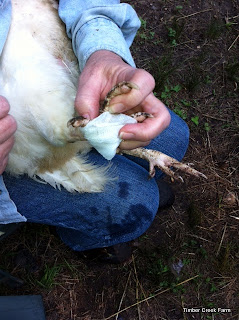You can treat bumblefoot in chickens when you are the only one home. This article is meant as an encouragement and not a diagnostic tool. When there is no one around to help you treat your chicken, you can learn to take care of the problem on your own.
I've read a lot of different articles on the treatment of bumblefoot in chickens, the causes, methods of taking care of it and the products to use. But very few address the subject of taking care of bumblefoot in your chicken when you have no one around to help you with the procedure. I will concede that it is easier to handle the situation when you have more than one person and two hands, but it is not impossible to successfully treat the chicken by yourself. If you are used to handling chickens and the case is caught fairly early, there is no need to rush to the veterinarian or wait until someone else can be your assistant.
 |
| Cecily and Amelia discuss the subject of foot health |
Bumblefoot is a staphylococcus infection that occurs in chickens,and ducks. We have successfully treated a few cases at our farm. There is no veterinarian in our area interested in treating ducks or chickens although they will give you medications if needed. Most of what you need for a routine case of bumblefoot can be assembled into your first aid kit to have on hand before you discover any problems. *** I also strongly recommend that you watch a few videos or read articles on the causes and treatment of bumblefoot, because the purpose of this article is to encourage you to be able to treat it on your own, when necessary. You should be familiar with the infection and remedy before taking this on yourself and there are many reputable resources available on the internet.
 | |
| Cecily inspects her bandaged foot |
One of the early signs of bumblefoot shows up when you notice your chicken limping or being reluctant to put weight on one foot. The hen may be holding one leg up off the ground and standing on just one leg. Checking the bottom of the foot may show you something like this. I should mention, that while I was fully able to treat the chicken by myself, I was not able to hold the chicken and get a good photo.
Before you catch the chicken, prepare the needed bandages, ointments and wraps. I use vet wrap, neosporin ointment on a piece of gauze , Veterycin spray, and a strip of electrical tape. Take the strip of vet wrap and split it down the middle. I use a piece about a foot long. You will need two strips torn in half or three narrow strips about 1.5 inches by 12 inches long. You will also need a scalpal, which you can purchase at a farm supply store . Lay out all of your supplies and then catch your hen.
Here's the fun part. A long time ago, I was told that the best way to work on a chicken is to hold them on their back with the head tucked under your arm. It really does work. The chicken seems to calm down quickly and lay still without resisting too much.
Wear disposable gloves because you are dealing with an infection most likely caused by staphylococcus bacteria. Clean the area with fresh water, hydrogen peroxide and finish with a spray of Veterycin spray.
Next, using a scalpel, cut away the center or the hard area inside the bumble. It looks like a round scab on the bottom of the foot. There should not be a lot of bleeding. It is similar to taking out a splinter in early cases. In this case, I caught the symptoms very early on, and the corn like center practically popped out on it's own. Spray the area with Vetrycin again. Once you have removed the center, grab the gauze that has the antibiotic ointment on it. Apply it to the bottom of the foot and hold in place while you grab a strip of vet wrap. Begin with one end of the strip up the shank of the chicken's leg. Bring the strip down and between two of the toes, over the gauze piece and back up the underside of the foot. Continue up the back side of the leg and wrap around the leg. Continue weaving strips, through the toes, until the gauze is fairly covered and the wrapping is secured around the leg. Wrap securely but not so tight that circulation is cut off. Now, I apply a strip of 8 inches of electrical tape to help hold the bandage together. It also helps it stay on if you are in a humid environment or if the ground is wet from rain.

When you are done wrapping the wound, slowly let the hen return to an upright position and hold her while she steadies herself on her wrapped foot. The pain should be much less of an issue now that you have released the pressure and the "corn". In most cases, with proper bandage changes and cleanliness, the wound should heal up in a few weeks. Depending on the chicken yard conditions, you may need to change the bandage every day or if the yard is dry and the chicken seems to be doing well, you could change it every other day. It is important to keep it clean and bandaged until no sign of the bumblefoot remains.

After the procedure, Cecily enjoys some meal worms on the treatment table. Two weeks later the infection is gone but there is still a small wound so the foot still needs to be wrapped.

Cecily gets to free range for a few minutes after getting her new bandage. Once the infection is removed and treated, the chicken will eat, scratch and enjoy life as usual, while the foot heals.
Note * : I have found it relatively easy to work on my chickens when no one is available to help. I do not recommend this if you need to treat a duck.
http://www.backyardchickens.com/a/bumblefoot-how-to-treat-your-chickens-with-surgery-graphic-pics
http://www.fresh-eggs-daily.com/2012/03/bumblefoot.html
shared on
 Everything Home with Carol and http://blackfoxhomestead.com/the-homeacre-hop/the-homeacre-hop-26/
Everything Home with Carol and http://blackfoxhomestead.com/the-homeacre-hop/the-homeacre-hop-26/










I treated my runner duck using this same method a month ago. I love the "football carry" method when you're working by yourself! My duck was just as calm as could be when I was working on her foot. I think it's the only time I could ever define her as being calm as she's a nervous duck.
ReplyDeleteThanks for letting us know that it can work with a duck! I have managed to work on a duck foot by myself too but it usually is more difficult to get them to calm down. I am glad you had good results.
ReplyDeleteWow. That is some great work lady! I haven't had that problem with my chickens yet. How common is it?
ReplyDeleteThanks for sharing on the Independence Days Challenge!
Hi Colleen Thanks for the comment and question. It is not uncommon. But it doesn't happen all the time either. I probably have one or two incidents a year with around 25 to 30 chickens in my flock
ReplyDeleteI hope we never have this issue, but thanks for sharing the information. I have seen several posts on it, but your perspective was different. Thanks for sharing!
ReplyDeletePlease join us again Thursday at:
The HomeAcre Hop
~Ann
Now, I know the best way to treat this!! Thanks for this great tutorial, Janet!
ReplyDelete